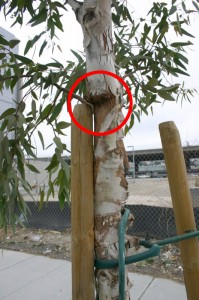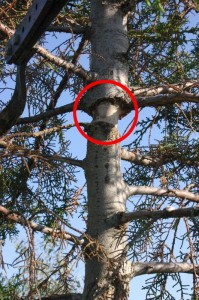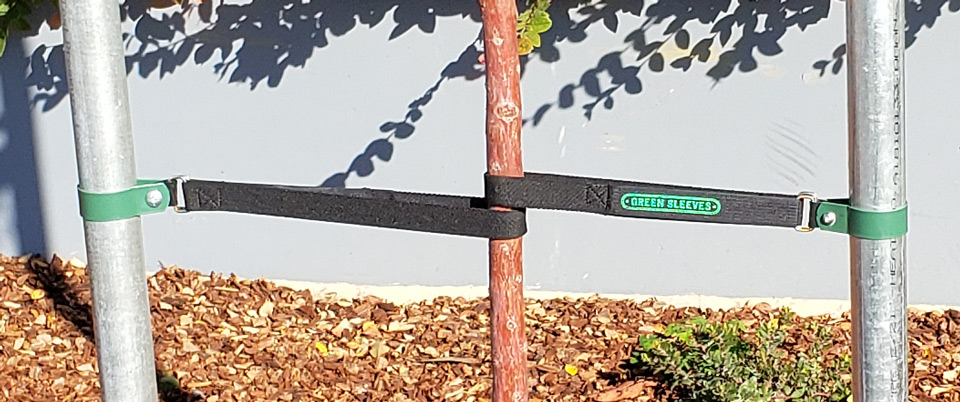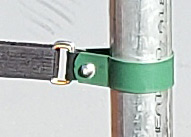Frequently Asked Questions
Q. Why is adjusting the tie on a staked tree so important?
A. If the tie around the young tree trunk isn’t moved regularly, it will eventually scrape through the bark of the tree and damage the cambium layer as shown in the photograph below. This tree was severely damaged by a tie that was never moved during the critical first months.

Damage to cambium layer from stakes rubbing against the bark
Q. Why is that so important? What’s cambium?
A. A tree’s cambium is a thin layer of cells lying between the wood and bark of the stem or trunk. This layer of cells is where new bark and wood cells originate, in addition to producing the cells that become the vascular system of the tree. If this layer of cells is damaged, the tree will never recover.
Q. Don’t all the other systems out there have a way to adjust the ties?
A. Sure, but the process is laborious and difficult. Ties are usually nailed to the stake. The nail needs to be pulled, the tie needs to be re-positioned, and the tie needs to be re-nailed into the wooden pole that’s been pounded into the soil. It’s not easy to do! It takes time, tools, effort, and more than a little skill (try pounding a nail into an upright wooden pole – it’s not easy). Using a Green Sleeve, you loosen the sleeve with a single turn of the screw, reposition the tie and sleeve, and tighten the bolt. The entire process takes only a few seconds.
Q. Why do I need to have a cross-beam? What function does it serve?
A. The stakes need to be stabilized so they don’t collapse into the crown of the tree. Usually this is done by nailing a piece of plywood between the wooden stakes. Over time, as the wood dries, the nails work themselves free, the beam falls off, and the stakes fall into the center of the tree, damaging or breaking branches, and rubbing against the bark and harming the cambium. Have a look at the tree in photo to left that has been damaged by its stakes collapsing. Cross beams keep the staking assembly stable and secure. As the tree grows, the cross beam should be moved out of the way of new branches, so the same technique we employ to move the straps is also used to move the cross beams – and the operation takes seconds instead of upwards of an hour.
Q. We live in an arid and windy place, and prefer using steel stakes on our trees as they provide better strength. Will Green Sleeves work with metal stakes?
A. Yes, Green Sleeves works with both wooden and metal stakes. Please see the architectural drawings to determine which size Green Sleeve will work with your stakes.
Q. I notice you can use either thumb nuts, hex bolts, or Allen screws for securing the sleeve to the stake. Why the choice?
A. We offer 3 different ways to secure Green Sleeves to the stakes, depending on where you are installing. Thumb nuts are obviously the easiest fastener, but should only be used in low-crime areas (i.e., a private backyard,) as they require no tools to remove. The medium-security system is the hex bolt, and the most-secure method is using Allen bolt. The hex and Allen bolts should be used in public spaces, parks, boulevards, etc.
Q. What kind of ties should I use?
A. Green Sleeves has been designed to work with corded rubber tree ties. The length you should use is determined by the size of the tree you are planting. A length of 30″ works well for 24″ box trees, longer lengths (approximately 60″) should be used on 36″ box trees.
Q. Where is Green Sleeves manufactured? Do you use recycled materials?
A. Green Sleeves is manufactured from 70% recycled materials in California, USA.




